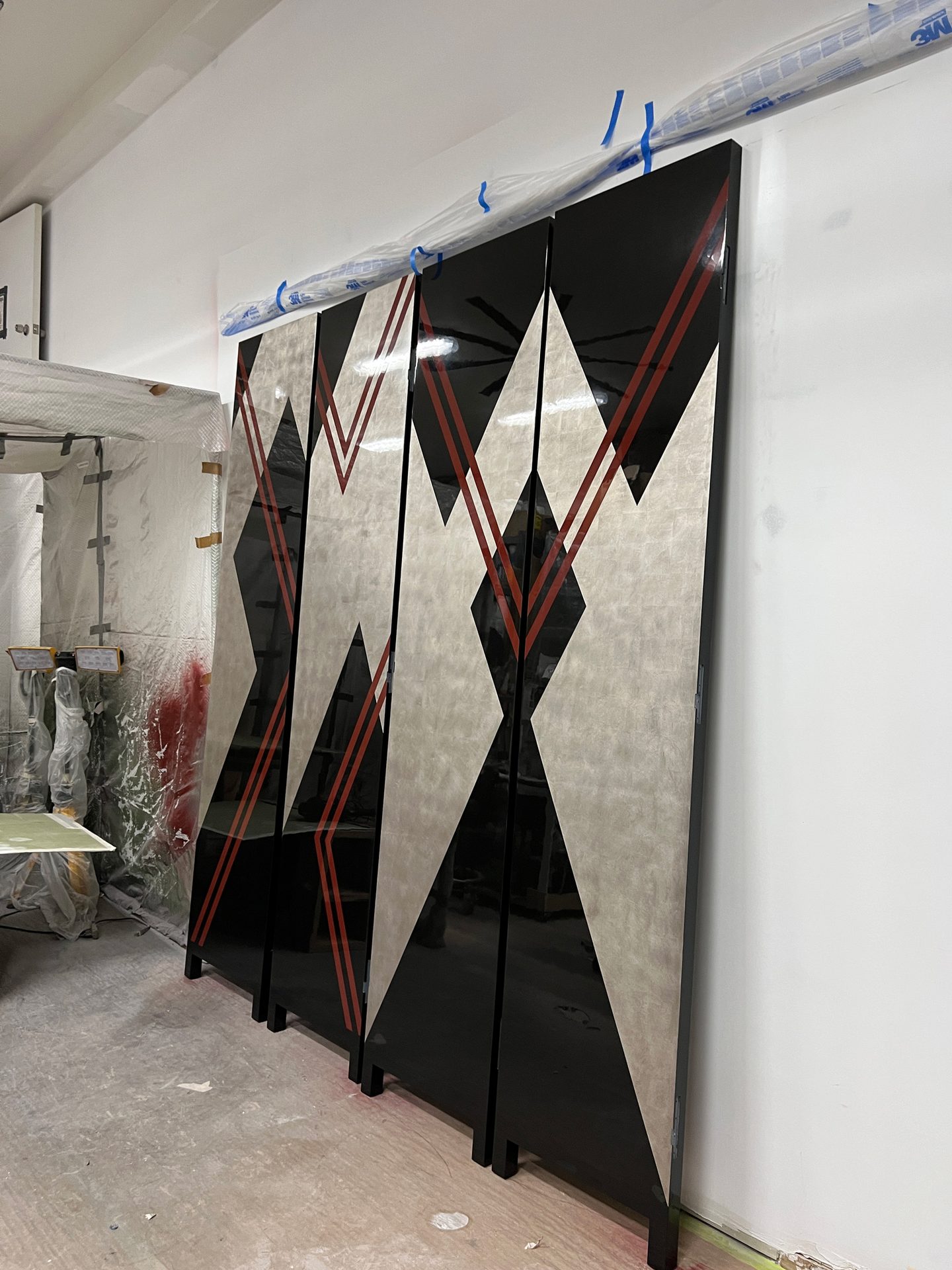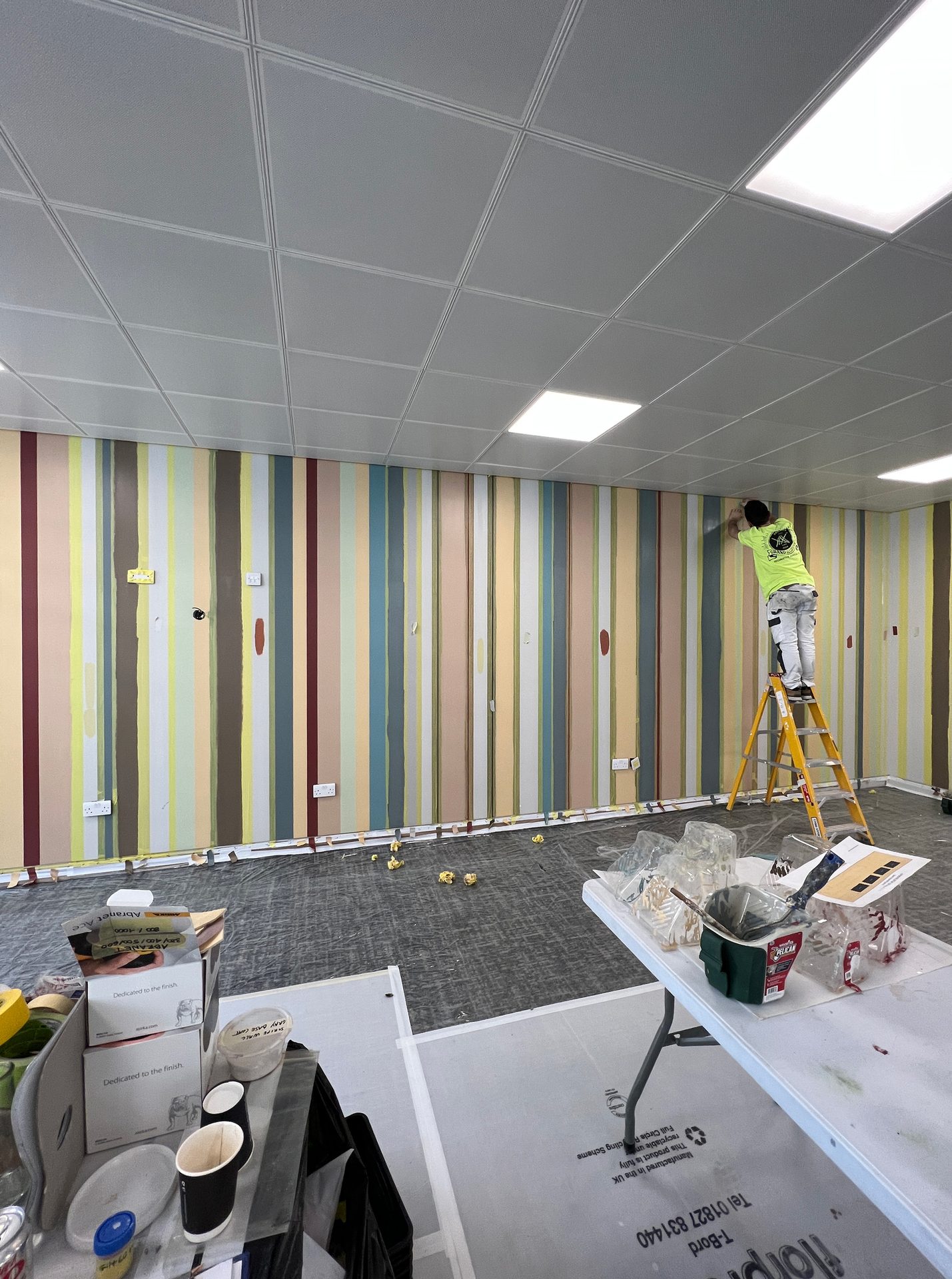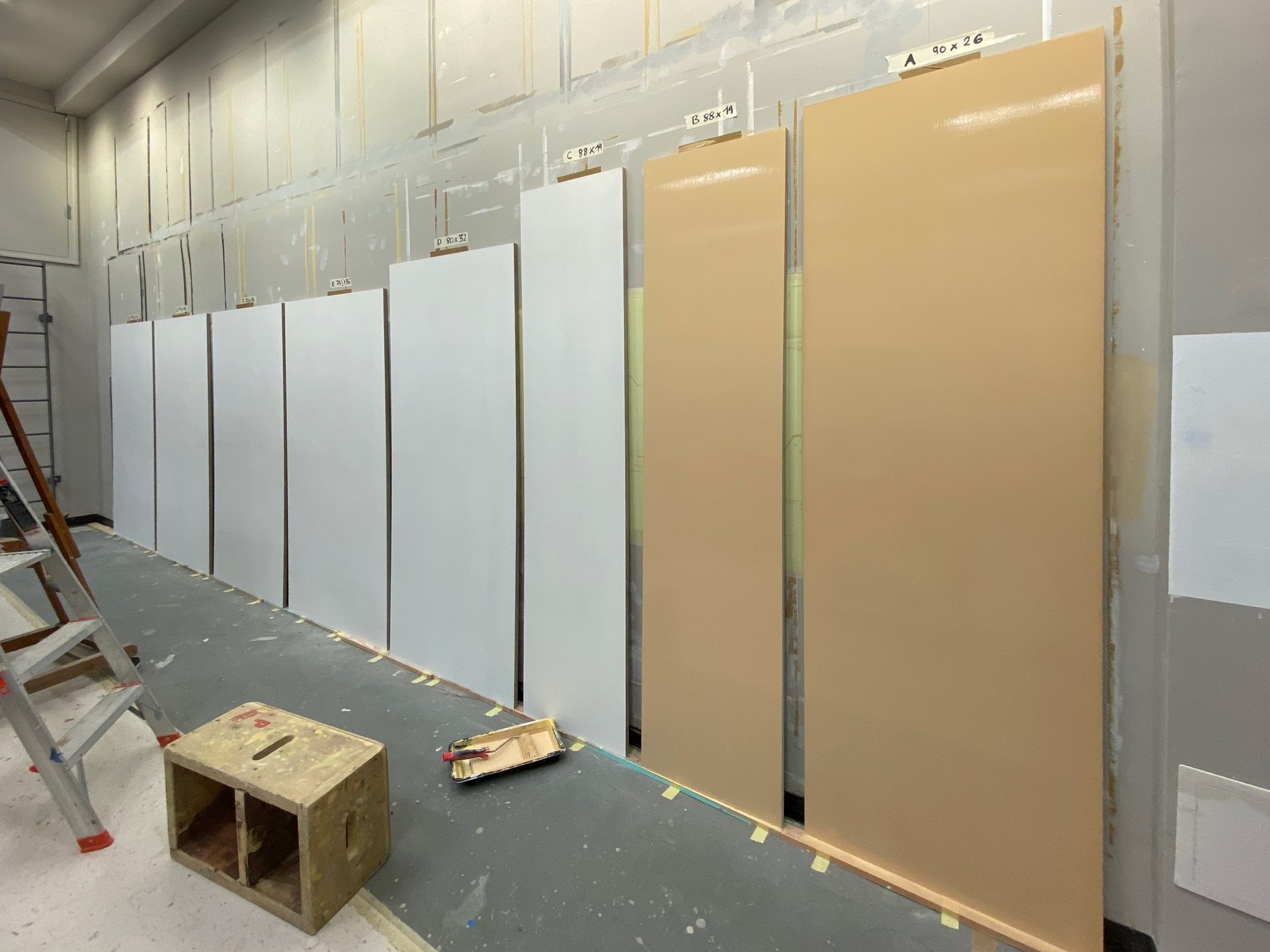Susan
Hines
Traditional Oil Paint Applications—Part 1
Capturing the look of traditional oil paint applications with today’s waterborne/hybrid options.
Pierre Finkelstein
ART AND CRAFT OF PLASTERING
If you’ve been a painter for more than 10 years, then you’ve had the opportunity to experience the look and feel of oil-based paints. Whether applying on walls with a roller or on millwork with a brush, traditional oil paint finishes had a specific quality.
In this article, we will look at the differences between traditional oil finishes and today’s waterborne, vinyl, and hybrid systems. We will look into this recent history of the gradual disappearance of oil paint and provide tips on how to render a waterborne system to mimic the best qualities of the traditional oil system.
In an upcoming article, part 2 of this series, we will review application methods and tricks to render waterborne paint to mimic the oil look, as well as painting with hybrid and waterborne lacquer.
When Oil and Alkyd Were the Norm
As a decorative painter and artisan with 40 years of experience, I have witnessed a broad shift in the use of oil paint to waterborne (latex) paint systems. It has been quite a gift in many ways, but it also brought many struggles. The entire painting trade had to make the change together as more products became restricted and therefore were no longer available.
When I started working in the trade in the mid-1980s, the stores were primarily stocking oil-based or alkyd-based paints. An alkyd is a modified resin of a synthetic polyester derived from various alcohols and acids. Alkyds are primarily used in varnishes, paints, and adhesives. In those days, there were so few options beyond oil or alkyd that even ceilings were coated with oil in a flat sheen.
Painters, who have only been in the trade for less than a decade, don't have the exposure to the nature of painting with oil. Its scarcity has become exponential since VOC restrictions have swept the country. VOC laws have cracked down on the use of many oil paints that prohibit the use of hazardous chemicals and products in paint.
VOC
As the 21st century rolled around, VOC laws came into effect, and the need for a cleaner, more environmentally friendly product gradually increased until today, as the waterborne/hybrid system has taken over almost completely, and manufacturers have stopped production of the oil paints. Exceptions today include specialty products for industrial sites or industry-specific types of work like boatyards. For these industries that paint over metal, glass, or other specialty surfaces, they require a more robust paint than what is currently available. However, it’s only a matter of time before a newer product will replace even the last remaining oil products of the past.
Current VOC restrictions vary from state to state. In the U.S., one will find much stricter laws in larger urban environments vs. rural towns. Generally speaking, most big cities across the US have tight restrictions on large buildings.
Flammable products of any kind are not allowed, especially if a building has a LEED certification. LEED certification is a globally recognized program that verifies a building's commitment to sustainability and energy efficiency.

A New Jersey office designed by Gensler, featuring a NanaWall HSW60 single-track system | Photography by Garrett Rowland Photography

The office of an Omaha financial institution designed by Alley Poyner Macchietto Architecture, featuring a Generation 4 acoustical, folding glass wall system.
A Brief History of House Paint
The origins of paint start with water. Back beyond antiquity (year 5000 BC), water was combined with a binder and pigment to create a medium. This system was gradually phased out and only used for distempered painting of ceilings.
Historically, since the late 19th century, the majority of painting was done with a traditional mix of linseed oil, turpentine, and pigments. Any traditionally trained painter would have learned how to mix their own paint using those basic ingredients.
The “mix-as-you-go” system continued up until the early 1950s when paint was pre-mixed into tins. It didn’t take long before the majority of paint was produced by manufacturers in tins. The paint was applied primarily by brush.
Another important revolution came with the invention of the paint roller. The first paint roller, made from lamb’s wool, was created in the 1940s. This made paint application faster and more even as walls were covered in a flash. The surface texture from a roller application is different from a brush which gives a change to the look of a room.
Waterborne vs Water-based
The terminology is very specific by using the word “waterborne" as opposed to “water-based”. It is a common error to call a waterborne acrylic or vinyl-based paint, water-based. Their origins lie with resin, not water.
The reason the terminology “waterborne” is correct is because they are emulsions that happen with water, but the origins are not water. The resin is derived by melting plastic beads with different acids and alcohol. This is the base for vinyl and acrylic paints. The resin is then pushed through a system that combines it with water. The results are tiny droplets that are suspended in water, thus the name emulsion. The water is just a vehicle to carry the resin and the pigment onto your surface.
3 Elements of Paint
A paint from any medium is composed with at least these three elements:
- A binder- the glue that binds the pigment to your surface (oil, resin, acrylic, vinyl)
- A solvent - the thinner that creates a viscosity that can be applied (water, paint thinner, alcohol)
- A pigment - colorant that tints your system (the only solid element of this recipe)
** There are several other additives that will modify the characteristics of each paint system that are added.

A New Jersey office designed by Gensler, featuring a NanaWall HSW60 single-track system | Photography by Garrett Rowland Photography

The office of an Omaha financial institution designed by Alley Poyner Macchietto Architecture, featuring a Generation 4 acoustical, folding glass wall system.
The Key Differences
Traditional oil finishes have a look and feel that are specific to the properties of oil. One of the most obvious differences is that oil gives you more time to work, great leveling quality and “sandability.” Waterborne finishes dry and cure fast, have an easier cleanup and application, but have more brush marks and are less sandable.
Application Marks
As previously mentioned, a primary difference between an oil and a waterborne paint system is that of dry time. Oil will dry slowly, giving the applicator more time to stretch or manipulate the paint. Due to the tool marks being more controlled, the result is a better finish. Additionally, as the paint dries, it will level, giving an even more professional look.
Waterborne (latex) paint will dry quicker, therefore allowing for less time to manipulate the paint. It’s not possible to go back into the drying paint without making worse tool marks. Using a roller to apply latex paint can also lead to dominant and heavy orange peel texture. Roller stipple and heavy brush marks are the telltale signs of a latex application.
Curing Time
As oil takes longer to dry, it also takes longer to cure than latex. Uncured paint is sticky, and it is susceptible to catching dust and airborne particles that can leave an undesired texture. Additionally, recoating a surface cannot happen the same day.
Latex paint, on the other hand, dries very fast. Curing happens so quickly it can be sanded and recoated the same day in most climates.
Clean Up and Yellowing
Cleanup for latex is a lot easier because of using just water and soap as opposed to solvents needed to break down the oil. Overtime oil will yellow, but latex will not.
So both have pros and cons in this breakdown.
Dry Time
So, as far as to why it dries so fast, water is the part that evaporates the quickest, leaving you with just the pigment trapped in the resin. Resin dries hard and prevents ambient dust from sticking.
In an oil system, the pigments are suspended directly with the oil or alkyd resin. The solvent is the thinner that allows the paint to be brushed or rolled onto your surface, leaving you with a slow-drying resin, trapping the pigment onto your surface.
My Experience
As an industry norm, our biggest issue with the waterborne system is the quick dry time. Yes, of course walls are an issue, but even smaller surfaces such as millwork (paneling, crown molding, baseboard, door & window casings and doors) can be a challenge. Paint dries too fast and doesn't allow time for a smooth application with a brush or roller. At the same time when you’re applying paint on walls with a roller, oftentimes results come with a very strong orange peel look that is undesirable. Remember decades ago, the walls were brushed and you would have those beautiful fine brush marks. This look is very difficult to get with the waterborne system.
New & Exciting Products
Today, the paint industry has modified some characteristics of some waterborne systems to behave more like the traditional oil system. Aesthetic standards are higher as consumers demand quality. Paint manufacturers are extending the open time (dry time). The result is better leveling in addition to making it stronger and more resilient like oil. We have come a long way since the early introduction of vinyl and acrylic paint. We now also have a new hybrid system that is a mixture of alkyd resin in a waterborne solution. Even more exciting are all of the latest waterborne lacquers that give incredibly hard, leveling finishes that dry fast and perform with any tools of paint application (brush, roller, sprayer).
A Decorative Painters Surface
All paint manufacturers have their benefits and quality. We, at GIDP, will always spec and use only the top tier of their paint because as a decorative painting company, the highest quality substrate allows for the best results with the minimum effort. The labor is far more costly than the product, so why not choose the best?
Of course, there is room for the more contractor friendly products for large commercial outfits, but at that point orange peel or heavy brush marks do not seem to be an issue. In the follow up article, I will concentrate mostly on the high-end paint systems that we use day-in and day-out in order to achieve high-quality residential finishes.
4 Ways to make Latex waterborne finishes look like Oil
- Thin the paint
- Roll and tip
- Use hybrid products
- Add retarder
Conclusion
The reality of it is that both paint types have their rather bold differences, so the systems will understandably behave differently. In other words, use the characteristics and positives of each system to your advantage.
Image Credit: Pierre Finkelstein Institute of Decorative Painting, Inc.
Pierre Finkelstein owner of Grand Illusion Decorative Painting Inc.
